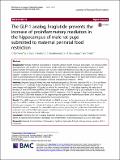Por favor, use este identificador para citar o enlazar a este item:
http://hdl.handle.net/10261/173042COMPARTIR / EXPORTAR:
 SHARE SHARE
 CORE
BASE CORE
BASE
|
|
| Visualizar otros formatos: MARC | Dublin Core | RDF | ORE | MODS | METS | DIDL | DATACITE | |

| Campo DC | Valor | Lengua/Idioma |
|---|---|---|
| dc.contributor.author | Diz-Chaves, Yolanda | - |
| dc.contributor.author | Toba, L. | - |
| dc.contributor.author | Fandiño, J. | - |
| dc.contributor.author | González-Matías, Lucas C. | - |
| dc.contributor.author | García-Segura, Luis M. | - |
| dc.contributor.author | Mallo, F. | - |
| dc.date.accessioned | 2018-12-09T04:26:20Z | - |
| dc.date.available | 2018-12-09T04:26:20Z | - |
| dc.date.issued | 2018-12-05 | - |
| dc.identifier.citation | Journal of Neuroinflammation 15(1): 337 (2018) | - |
| dc.identifier.uri | http://hdl.handle.net/10261/173042 | - |
| dc.description.abstract | [Background]: Perinatal maternal malnutrition is related to altered growth of tissues and organs. The nervous system development is very sensitive to environmental insults, being the hippocampus a vulnerable structure, in which altered number of neurons and granular cells has been observed. Moreover, glial cells are also affected, and increased expression of proinflammatory mediators has been observed. We studied the effect of Glucagon-like peptide-1 receptor (GLP-1R) agonists, liraglutide, which have very potent metabolic and neuroprotective effects, in order to ameliorate/prevent the glial alterations present in the hippocampus of the pups from mothers with food restriction during pregnancy and lactation (maternal perinatal food restriction—MPFR). | - |
| dc.description.abstract | [Methods]: Pregnant Sprague-Dawley rats were randomly assigned to 50% food restriction (FR; n = 12) or ad libitum controls (CT, n = 12) groups at day of pregnancy 12 (GD12). From GD14 to parturition, pregnant FR and CT rats were treated with liraglutide (100 μg/kg) or vehicle. At postnatal day 21 and before weaning, 48 males and 45 females (CT and MPFR) were sacrificed. mRNA expression levels of interleukin-1β (IL1β), interleukin-6 (IL-6), nuclear factor-κβ, major histocompatibility complex-II (MHCII), interleukin 10 (IL10), arginase 1 (Arg1), and transforming growth factor (TGFβ) were assessed in the hippocampus by quantitative real-time polymerase chain reaction. Iba1 and GFAP-immunoreactivity were assessed by immunocytochemistry. | - |
| dc.description.abstract | [Results]: The mRNA expression IL1β, IL6, NF-κB, and MHCII increased in the hippocampus of male but not in female pups from MPFR. In addition, there was an increase in the percentage of GFAP and Iba1-immupositive cells in the dentate gyrus compared to controls, indicating an inflammatory response in the brain. On the other hand, liraglutide treatment prevented the neuroinflammatory process, promoting the production of anti-inflammatory molecules such as IL10, TGFβ, and arginase 1, and decreasing the number and reactivity of microglial cells and astrocytes in the hippocampus of male pups. | - |
| dc.description.abstract | [Conclusion]: Therefore, the GLP-1 analog, liraglutide, emerges as neuroprotective drug that minimizes the harmful effects of maternal food restriction, decreasing neuroinflammation in the hippocampus in a very early stage. | - |
| dc.description.sponsorship | Financial support from the Xunta de Galicia (Centro singular de Investigación de Galicia accreditation 2016–2019, ED431G/02; Modalidad Grupos con Potencial Crecimiento GPC2015/022 and Agrupaciones Estratégicas CN2012/273) and the European Union (European Regional Development Fund-ERDF) is gratefully acknowledged. | - |
| dc.publisher | BioMed Central | - |
| dc.rights | openAccess | - |
| dc.subject | Maternal food restriction | - |
| dc.subject | Inflammation | - |
| dc.subject | Cytokines | - |
| dc.subject | Microglia | - |
| dc.subject | Astroglia | - |
| dc.subject | Hippocampus | - |
| dc.subject | Incretins | - |
| dc.subject | GLP-1 | - |
| dc.subject | Liraglutide | - |
| dc.title | The GLP-1 analog, liraglutide prevents the increase of proinflammatory mediators in the hippocampus of male rat pups submitted to maternal perinatal food restriction | - |
| dc.type | artículo | - |
| dc.identifier.doi | 10.1186/s12974-018-1370-7 | - |
| dc.relation.publisherversion | https://doi.org/10.1186/s12974-018-1370-7 | - |
| dc.identifier.e-issn | 1742-2094 | - |
| dc.date.updated | 2018-12-09T04:26:21Z | - |
| dc.language.rfc3066 | en | - |
| dc.rights.holder | The Author(s). | - |
| dc.rights.license | http://creativecommons.org/licenses/by/4.0/ | - |
| dc.contributor.funder | Xunta de Galicia | - |
| dc.contributor.funder | Consejo Superior de Investigaciones Científicas (España) | - |
| dc.contributor.funder | European Commission | - |
| dc.relation.csic | Sí | - |
| dc.identifier.funder | http://dx.doi.org/10.13039/501100003339 | es_ES |
| dc.identifier.funder | http://dx.doi.org/10.13039/501100000780 | es_ES |
| dc.identifier.funder | http://dx.doi.org/10.13039/501100010801 | es_ES |
| dc.identifier.pmid | 30518432 | - |
| dc.type.coar | http://purl.org/coar/resource_type/c_6501 | es_ES |
| item.fulltext | With Fulltext | - |
| item.openairecristype | http://purl.org/coar/resource_type/c_18cf | - |
| item.openairetype | artículo | - |
| item.cerifentitytype | Publications | - |
| item.grantfulltext | open | - |
| Aparece en las colecciones: | (IC) Artículos | |
Ficheros en este ítem:
| Fichero | Descripción | Tamaño | Formato | |
|---|---|---|---|---|
| 12974_2018_Article_1370.pdf | 1,91 MB | Adobe PDF |  Visualizar/Abrir |
CORE Recommender
PubMed Central
Citations
17
checked on 20-abr-2024
SCOPUSTM
Citations
28
checked on 19-abr-2024
WEB OF SCIENCETM
Citations
28
checked on 25-feb-2024
Page view(s)
365
checked on 24-abr-2024
Download(s)
190
checked on 24-abr-2024

